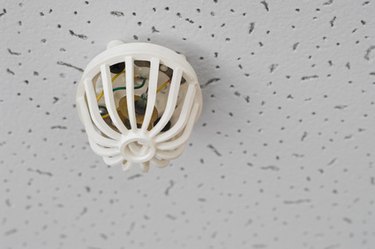
Carbon monoxide, or the "silent killer" as it is sometimes called, is an odorless gas that is produced by burning fuel. Running cars, portable heaters, clothes dryers and blocked chimneys can all be responsible for a carbon monoxide in your home. CO poisoning kills between 200 and 300 people in their homes yearly, according to the U.S. Consumer Product Safety Commission (CPSC), which is why it recommends that all homes be equipped with a carbon monoxide detector.
Carbon Monoxide
Video of the Day
Joseph Priestley, an English chemist, first discovered carbon monoxide and described its differences from carbon dioxide between 1772 and 1799. Since that time, scientists have gradually discovered the poisonous nature of the gas. It was these early findings that established the eventual need for CO regulations and alarm systems in homes and businesses. The U.S. Occupational Safety and Health Administration has since limited the amount of carbon monoxide allowed in workplaces to 35 parts per million.
Video of the Day
Early Detector Patent
An early version of a carbon monoxide detector was developed in 1925 by Chester Gordon and James Lowe, employees of the American Telephone and Telegraph Company. The device was intended to aid commercial workers in detecting the gas in confined spaces like manholes. The first CO detector was not similar to the modern version; it involved manually crushing a glass container filled with palladium chloride, acetone and other chemicals in order to detect CO.
Smoke Alarms
The first battery-operated, residential smoke detector was a predecessor to residential carbon monoxide alarms. BRK Electronics, now known for manufacturing the First Alert home alarm system brand, produced the first residential smoke alarms to receive approval from Underwriters Laboratories Inc. (UL). The alarm was introduced in 1969 and proved successful. Today, 94 percent of U.S. homes are equipped with smoke alarms. After the smoke alarm took off, BRK set to work developing other home safety products, like rechargeable lanterns, flash lights, disposable fire extinguishers and, of course, the CO detector.
Industry Standards
In May of 1992, in anticipation of a newly announced carbon monoxide detector which was scheduled to hit the markets, the CPSC and UL published standards for CO alarms. It stated that the devices must sound an alarm before carbon monoxide reached dangerous levels. The UL also required that the new CO detectors be able to distinguish between CO and other similar gases, like butane, methane and carbon dioxide. This standard, referred to as UL 2034, is continually updated.
Current Models
The battery-powered carbon monoxide detectors many people currently use first came on the market in 1993. There are now three main types of detectors. The electrolytic sensor is expensive, but it's also the most sensitive. Colorimetric detectors measure CO buildup over time, and metal oxide semiconductor sensors can detect chlorine bleach and silicone as well as CO. After coming out with the residential CO alarm, BRK introduced its combination smoke and CO detector in 1996 and the remote control CO alarm in 2000.